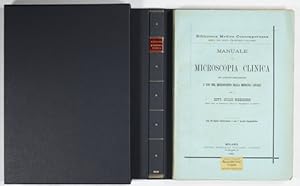Riguardo questo articolo
Milano, Dottor Francesco Vallardi, Editore, Via Disciplini, 15, 1880, 8°, 174, (2) pp., 22 fig., 7 lith. plates, 7 explanation leaves; Catalgo Generale della Biblioteca Medica Contemporanea, 1880, 64 pp., orig. wrappers; uncut fine coppy. RARE First Edition, 2nd. Issue! Contenuto: "Descrizione et uso del microscopio; Esame del sangue; Esame degli essudati; Esame delle pelle; Esame del contenuto boccale; Esame del vomito; Esame degli feci; Esame degli Sputi; Esame del musco nasale; Esame dell' occhio e delle parti annesse; Esame dello sperma; Esame delle ecrezioni dei genitali; Esame del secreto delle mammelle; esame dell' orina." Content: Description and use of microscope; Examination of blood; Examination of exudates; Examination of skin; Examination of mouth contents; Examination of vomit; Examination of feces; Examination of sputum; Examination of nasal muscus; Examination of eye and adnexal parts; Examination of semen; Examination of genital ecretions; Examination of udder secretions; Examination of urine. Giulio Bizzozero (1846-1901) "was an eminent Italian pathologist, the first microscopist to describe the role of platelets as the third morphological element of the blood. He also made innovative discoveries about the haematopoietic function of the bone marrow, the histological structure of the epidermis, phagocytosis and many other original intuitions. Since the beginning, his career was extremely productive: for his valuable research work, at the age of 26 he was appointed full Professor of General Pathology at the University of Turin, Italy. Here he emphasised the use of microscopy against the outdated vision of old academics and promulgated experimental methods in opposition to the vitalistic philosophy of the time. Bizzozero's revolutionary vision of medicine aimed to allow every scientist to reach new discoveries in their field, which were previously the privilege of an elite, making him a model both as a doctor and as a humanist. The advancement of his studies and the development of the art of microscopy led to the publishing of his masterpiece "Manuale di Microscopia Clinica" (Handbook of Clinical Microscopy) in 1879. In that, he underlined how the microscopic examination of the urine gave physicians of the time indicative criteria of kidney alterations, often essential for diagnosis. The author makes a detailed analysis of the methods of his time, laying the foundations for modern microscopy and the diagnosis of renal diseases. " G. Bellinghieri, et al.: The role of the microscope in renal disease as described in Giulio Bizzozero's handbook of clinical microscopy. Archives of Hellenic Medicine 2020, 37(Suppl 2): pp.108-113 See - Paolo Mazzarello, Alessandro L. Calligaro and Alberto Calligaro: Giulio Bizzozero: a pioneer of cell biology. Nature, Oct. 2001, pp.776ff. Not in Osler, Waller, Surg. Gen. Cat.; Heirs of Hippocrates. Codice articolo 45936
Contatta il venditore
Segnala questo articolo
![]()




